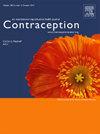Psychometric evaluation of the desire to avoid pregnancy scale in India
IF 2.3
2区 医学
Q1 OBSTETRICS & GYNECOLOGY
引用次数: 0
Abstract
Objective
This study aimed to evaluate the psychometric performance of the Desire to Avoid Pregnancy (DAP) scale in India.
Study design
We utilized survey data from married women enrolled in a family planning intervention in Maharashtra, India, who provided responses to the 14-item DAP scale at 18-month intervention study follow-up. We assessed scale internal consistency using Cronbach α and used exploratory factor analysis to evaluate scale unidimensionality and item response theory (IRT) to assess item performance. We used regression models to assess whether DAP predicts current reported contraceptive use, as well as future contraceptive use and pregnancy, to evaluate construct validity.
Results
A total of 1088 participants responded to 18-month intervention study follow-up survey; 99% of eligible participants (887/888) provided the full-scale response. One item, "makes me smile," performed in the reverse direction as anticipated (negative item-test correlation) and was excluded for use in this analysis. The mean 13-item DAP score (DAP-13) was 2.14 of 4 (SD 0.95, range 0–4); internal consistency was high (Cronbach α = 0.92). Most items fit the partial credit model on IRT. Exploratory factor analyses supported either a one- or two-factor model; the unidimensional model was considered acceptable for use as the single factor explained 71% of all variance, and all items had stable absolute factor loadings ≥0.38. DAP-13 score only differed by parity; nulliparous women had the lowest scores (0.56), followed by women with one (1.94), two (2.60), or three or more births (2.56; p < 0.001). A one-point increase in DAP-13 was associated with greater odds of current contraception use reported at time of DAP assessment (adjusted odds ratio [aOR] 1.79, 95% CI 1.43–2.26), subsequent contraception use reported 18 months after DAP assessment (aOR 1.88, 95% CI 1.44–2.44), and half the odds of subsequent pregnancy in the 18-month period after DAP assessment (aOR 0.57, 95% CI 0.46–0.71).
Conclusions
The DAP scale demonstrated good reliability and unidimensionality in this population. Higher DAP scores were associated with higher odds of contraception use and lower odds of pregnancy, supporting construct validity. Future research on the DAP scale in Maharashtra should explore alternative translations of the "makes me smile" item that better capture local expressions of joy about potential childbearing.
Implications
A modified version of the DAP scale is acceptable for use in an Indian population and can be utilized in future research and program evaluation that focus on contraception and pregnancy prevention in this context. One item was excluded and requires additional formative research to better capture the intended emotional valence in this cultural context.
Clinical trial registration number
NCT03514914
印度避免怀孕愿望量表的心理测量学评价。
研究设计:我们利用了印度马哈拉施特拉邦参加计划生育干预的已婚妇女的调查数据,这些妇女在18个月的干预研究随访中提供了对14项DAP量表的回应。采用Cronbach’s α评价量表的内部一致性,采用探索性因子分析评价量表的单向度,采用项目反应理论(IRT)评价量表绩效。我们使用回归模型来评估DAP是否预测当前报告的避孕使用,以及未来的避孕使用和怀孕,以评估结构效度。结果:1088名参与者参与了18个月的干预研究随访调查;99%的符合条件的参与者(n= 888中的n=887)提供了全量表反应。有一个项目的表现与预期相反(负项目-测试相关),并被排除在本分析中。平均13项DAP得分(DAP-13)为2.14分(SD 0.95,范围0-4);内部一致性高(Cronbach α=0.92)。大多数项目符合IRT的部分信用模式。探索性因素分析支持单因素或双因素模型;单维模型被认为是可以接受的,因为单因素解释了71%的方差,所有项目都有稳定的绝对因素负荷≥0.38。DAP-13评分仅存在奇偶性差异;未生育妇女得分最低(0.56),其次是一胎(1.94),二胎(2.60),三胎及以上的妇女(2.56)。(结论:DAP量表在该人群中具有良好的信度和单一性。DAP得分越高,使用避孕措施的几率越高,怀孕的几率越低,支持结构效度。未来对马哈拉施特拉邦DAP量表的研究应该探索“让我微笑”项目的其他翻译,以更好地捕捉当地人对潜在生育的喜悦表达。意义:改良版的DAP量表在印度人群中是可以接受的,并且可以在未来的研究和项目评估中使用,重点是在这种情况下的避孕和预防怀孕。一个项目被排除在外,需要额外的形成性研究来更好地捕捉这种文化背景下预期的情感价。临床试验注册号:NCT03514914。
本文章由计算机程序翻译,如有差异,请以英文原文为准。
求助全文
约1分钟内获得全文
求助全文
来源期刊

Contraception
医学-妇产科学
CiteScore
4.70
自引率
17.20%
发文量
211
审稿时长
69 days
期刊介绍:
Contraception has an open access mirror journal Contraception: X, sharing the same aims and scope, editorial team, submission system and rigorous peer review.
The journal Contraception wishes to advance reproductive health through the rapid publication of the best and most interesting new scholarship regarding contraception and related fields such as abortion. The journal welcomes manuscripts from investigators working in the laboratory, clinical and social sciences, as well as public health and health professions education.
 求助内容:
求助内容: 应助结果提醒方式:
应助结果提醒方式:


